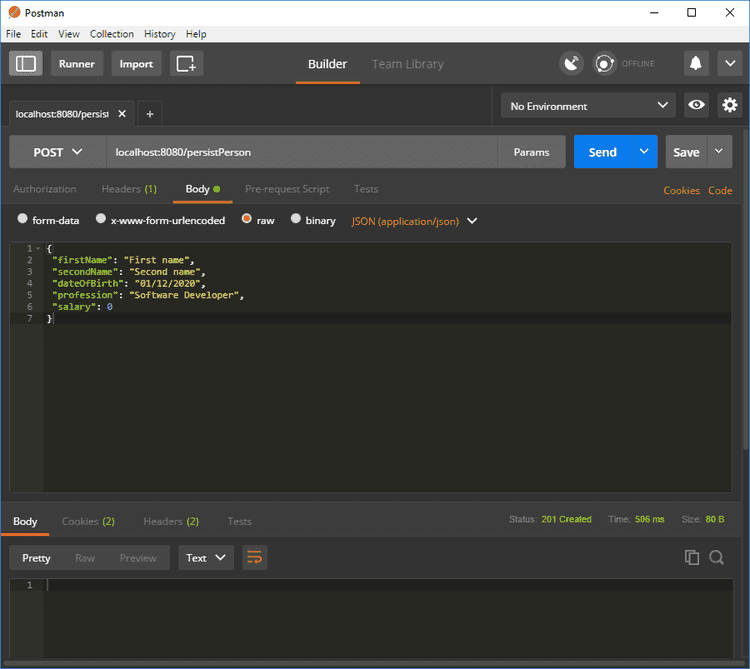A very quick and little tutorial into sending a POST request to a Rest Controller in Spring Boot.
Have a look at Spring’s starter guide if your starting from scratch. The setup that is not described in this post is covered there.
The Maven dependencies required in this post are
<dependencies>
<dependency>
<groupId>org.springframework.boot</groupId>
<artifactId>spring-boot-starter-web</artifactId>
</dependency>
<dependency>
<groupId>org.springframework.boot</groupId>
<artifactId>spring-boot-starter-test</artifactId>
<scope>test</scope>
</dependency>
</dependencies>The Rest Controller
@RestController
public class PersonRestController {
@Autowired private PersonService personService;
@Autowired private PersonRepository personRepository;
@RequestMapping(value = "/persistPerson", method = RequestMethod.POST)
public ResponseEntity<String> persistPerson(@RequestBody PersonDTO person) {
if (personService.isValid(person)) {
personRepository.persist(person);
return ResponseEntity.status(HttpStatus.CREATED).build();
}
return ResponseEntity.status(HttpStatus.I_AM_A_TEAPOT).build();
}
}The first thing to notice is that the class is annotated with @RestController allowing it to accept the requests that are sent to its path, which is ”/” as one has not been defined in this example. Some beans have been injected in using the @Autowired annotation allowing them to be used in this controller.
Onto the more POST specific code. @RequestMapping defines the path that the annotated method can accept requests from and specifies that this method accepts POST requests.
This method accepts requests from
the rest of the request .../persistPersonFor example
localhost:8080/persistPersonBy default if no method is mentioned then it will accept GET requests. @RequestBody marks that the person input is retrieved from the body / content of the POST request. This is a notable difference between GET and POST as the GET request does contain a body.
As POST requests are meant to be used to save new data to a database this example does just that, although none of the actual persistence code is actually implemented. If the input person is valid then it will call the repositories persist method and return a HttpStatus.CREATED (201) response code. This is the response code that is normally returned from a successful POST request. If the person was not valid then it returns a different response code. I used I_AM_A_TEAPOT (418) as it looked silly but it should probably be NO_CONTENT (204) or CONFLICT (409) although I there does not seem to be a consensus on what the correct response is.
To manually test this I used Postman. To send a POST request to the Rest Controller:
- Set the request type to POST
- Set the content type in the header to
application/json; charset=UTF-8 - Add the JSON for the
PersonDTOto the body of the request (in the raw option) - Add the request path
- Press send
If you haven’t already, startup your server before you try to send the request or obviously it wont wont.
Request path
localhost:8080/persistPersonBody
{
"firstName": "First name",
"secondName": "Second name",
"dateOfBirth": "01/12/2020",
"profession": "Software Developer",
"salary": 0
}These two pictures below should help make this clearer
It’s probably also a good idea to test the code. So lets look at how to do so.
import static org.mockito.BDDMockito.given;
import static org.mockito.Matchers.any;
import static org.mockito.Mockito.times;
import static org.mockito.Mockito.verify;
import static org.springframework.http.MediaType.APPLICATION_JSON_UTF8;
import static org.springframework.test.web.servlet.request.MockMvcRequestBuilders.post;
import static org.springframework.test.web.servlet.result.MockMvcResultMatchers.status;
@RunWith(SpringRunner.class)
@WebMvcTest(PersonRestController.class)
public class PersonRestControllerTest {
@Autowired private MockMvc mockMvc;
@Autowired private ObjectMapper objectMapper;
@MockBean private PersonService personService;
@MockBean private PersonRepository personRepository;
private JacksonTester<PersonDTO> jsonTester;
private PersonDTO personDTO;
@Before
public void setup() {
JacksonTester.initFields(this, objectMapper);
personDTO = new PersonDTO();
}
@Test
public void persistPerson_IsValid_PersonPersisted() throws Exception {
final String personDTOJson = jsonTester.write(personDTO).getJson();
given(personService.isValid(any(PersonDTO.class))).willReturn(true);
mockMvc
.perform(post("/persistPerson").content(personDTOJson).contentType(APPLICATION_JSON_UTF8))
.andExpect(status().isCreated());
verify(personRepository).persist(any(PersonDTO.class));
}
@Test
public void persistPerson_IsNotValid_PersonNotPersisted() throws Exception {
final String personDTOJson = jsonTester.write(personDTO).getJson();
given(personService.isValid(any(PersonDTO.class))).willReturn(false);
mockMvc
.perform(post("/persistPerson").content(personDTOJson).contentType(APPLICATION_JSON_UTF8))
.andExpect(status().isIAmATeapot());
verify(personRepository, times(0)).persist(any(PersonDTO.class));
}
}The @WebMvcTest annotation is used which will disable full auto-configuration and only apply configuration relevant to MVC tests including setting up the MockMvc used in this test. The PersonRestController has been marked in the annotation as it is the test subject. Using MockMvc provides a faster way of testing MVC controllers like the PersonRestController as it removes the need to fully start a HTTP server. @MockBean is used on each bean that was injected into the PersonRestController so that they are then mocked in the tests.
Each test converts the personDTO into JSON using the JacksonTester and sends a POST request that includes the JSON in its body / content. The tests will pass if the correct response code is returned and if personRespository.persist was called the correct amount of times. Mockito is used to mock the return of the personService.isValid method and to verify if personRepository.persist was called or not.
By reaching this point you should be able write a simple Rest Controller that can accept POST requests and be able to manually test it with Postman and automatically with a test.
The code used in this post can be found on my GitHub.


